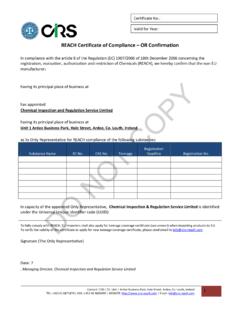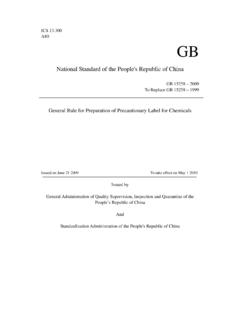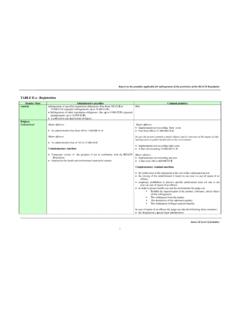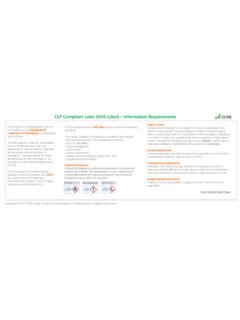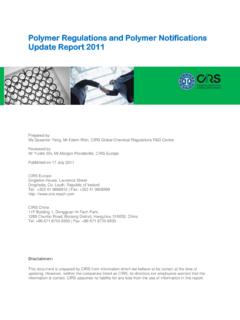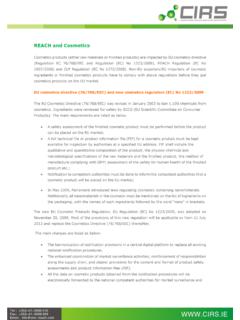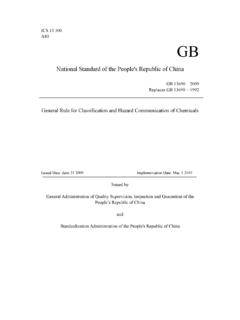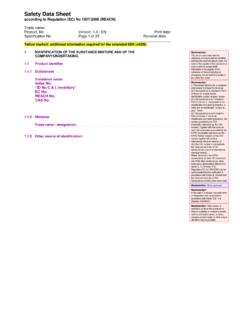Transcription of GB - Chemical Inspection and Regulation Service
1 ICS G04. GB. National Standard of the People's Republic of China GB/T 16483-2008. To Replace GB/T GB 16483-2000. Safety Data Sheet for Chemical Products Content and Order of Sections Issued on: 18 June 2008 To take effect on: 1 Feb 2009. Issued by General Administration of Quality Supervision, Inspection and Quarantine of the People's Republic of China And Standardization Administration of the People's Republic of China Foreword This standard will replace GB/T Chemical Products Safety Data Sheet: Section 1: Content and Order of Sections, and GB 16483-2000 General rules for the Preparation of Safety Data Sheet for Chemical Products. Compared with GB/T , and GB 16483-2000, this standard has the following main differences: The order of 16 parts of information is different;. The definition of substance is added;. In of Appendix A, the summary of hazard is consistent with the classification of Globally Harmonized System of Classification and Labeling of Chemicals (GHS).
2 The Appendix A of this standard is normative. This standard is proposed by China Petroleum and Chemical Industry Association. This standard is to be interpreted and administered by the National Chemical Standardization Technology Commission. The following organizations have participated in the preparation of this standard: National Registration Center for Chemicals, State Administration of Work Safety, SINOCHEM Standardization Institute, Shanghai Chemical Engineering Research Institute, China Chemical Economic and Technology Development Center, China Sinopec Qingdao Safety Engineering Institute. Main drafters: Wei Jing, Li Xuehua, Li Yuncai, Zhong Zhiwan, Yang Yi, Liu Gang, Chen Jun, Ji Guofeng. The released versions of standards replaced by this standard are: GB/T ;. GB 16483-1996; GB 16483-2000. GB/T 16483-2008. Foreword The Safety Data Sheet (SDS) provides information on Chemical products (substance or mixture) in the aspects of safety, health, environment, etc, recommending precautionary measures and measures for emergency response.
3 In some countries, the Safety Data Sheet for Chemical Products is also named as the Material Safety Data Sheet (MSDS), but in this standard SDS is used consistently. The SDS is a hazard communication tool for the suppliers of Chemical products to convey the basic information (including transportation, Operation, Disposal, storage and emergency action information) on the hazards of chemicals to the recipients. At the same time the SDS can convey such information to the public institutions, Service providers and other stakeholders of the chemicals. This standard is designed to standardize the information on Chemical products in the aspects of safety, health, and environment, establishing unified format (such as terminology, numbering and sequence of titles), making specific rules on how to provide information on Chemical products in SDS. This standard can be applied flexibly in the information communication between different languages. ISO11014-1 Standard Version 1 has been promulgated in 1994.
4 Afterwards it has been widely applied worldwide. The National Chemical Standardization Technical Committee identically converted ISO11014-1: 1994 to GB/T The 1992 United Nations Conference on Environment and Development (UNCED). passed the 21st century agenda, where UNCED recommended the Globally Harmonized System of Classification and Labeling of Chemicals (GHS). In Chapter 19 of the agenda, Management of Toxic Chemical in Environment includes 6 basic measures, while the SDS is one of them. GHS Version 1 has been released in 2003, and revised for the first time and second time in 2005 and 2007 respectively, which includes the guidance to develop the SDS. The SDS standards in some countries and regions have been revised in accordance with the requirements of GHS. ISO/TC 47 made systematic checking of ISO11014-1: 1994 in 2006, afterwards we decided to revise the standard. Therefore, this international standard was developed through revising the Version 1 so that it complies with the requirements of GHS for SDS for communicating information on the hazards of chemicals.
5 The National Chemical Standardization Technical Committee decided to revise GB/T. simultaneously. ISO/TC 47 also revised the name of ISO11014-1 international standard by deleting the Section 1 , because since releasing Section 1 in 1994, the planned Section 2 of ISO11014 has not been released till now. It is not necessary for SDS to reflect or describe the regulatory requirements of different countries or regions. These requirements may only apply to some specific countries and regions. Therefore it is recommended that the generators of SDS. should know about the regulations of different countries and regions on generating SDS, so that it helps that each Chemical only corresponds to one SDS in different countries or regions. The responsibilities of the recipients of SDS are beyond the scope of this international standard. This standard describes a part of the responsibilities of the recipients to draw a clear distinction between the responsibilities of SDS suppliers and recipients.
6 GB/T 16483-2008. Safety Data Sheet for Chemical Products Content and Order of Sections 1 Scope This standard sets the structure, content and generic forms of the Safety Data Sheet for Chemical Products (SDS).This standard applies to the preparation of the Safety Data Sheet for Chemical Products. This standard does not provide fixed format or sample for SDS. 2 Terminology and definitions The following terminology and definition apply to this standard. Chemical product It refers to substance or mixture. Substance It refers to the Chemical elements and their compounds in the natural status or obtained through any manufacturing process, including any necessary additives to keep its stability and any impurities as a result of processing, but excluding any separable solvent that will not affect the stability of the substance or change its composition. Exposure control The whole set protective measures to protect the personnel exposed to the Chemical products.
7 GHS classification According to the features of physical, healthy, and environmental hazards of substance or mixture, based on the classification standard of the Globally Harmonized System of Classification and Labeling of Chemicals (GHS), classify the hazards of substances. Harm It refers to the physical harm or hazard to the health of humans and the damage caused to property or environment. Hazard Potential source of danger Hazard statement It refers to the statement for hazard type and class, describing the fixed danger of a certain Chemical products, including hazard degree if necessary. Ingredient It refers to the ingredients of a certain Chemical product. Intended use It refers to the allowed use specified in the information provided by the supplier on product, process and Service . Label It refers to the combination of words, graphic symbols and coding that indicates the hazard and safety notes for the Chemical products. It can be pasted, printed or tagged to package or container of the Chemical product.
8 Label element It refers to the kind of information on the labels indicating the hazard of Chemical products, such as graphic symbols, signal words etc. Precautionary statement It refers to the relevant measures described through words or graphic symbols to reduce or prevent exposure to dangerous chemicals and to ensure correct storage and transport. Preparation It refers to the mixture or solution composed of two or more substances. Pictogram It refers to the graphic combination indicating specific information comprised of symbols and other graphic elements, such as frames, background graphic and color. Reasonably foreseeable misuse It refers to the misuse with very high probability of being misused in the actual use, which is not in the allowed scope of use specified in the information provided by the supplier on product, process and Service . Recipient It refers to the intermediary personnel or end users receiving Chemical products from suppliers for industrial or professional use, such as storage, transport, processing or packing.
9 Risk It refers to the probability to cause hazard and the serious degree of hazard. Safety It refers to avoiding unacceptable risk. Signal word It refers to the words on the labels to indicate the relative serious degree of the hazard of Chemical products and warn the person exposed to the Chemical products to pay attention to the potential hazard. For example, GHS stipulates that Danger . and Warning can be used as the signal words . Supplier It refers to the groups supplying a certain Chemical product to the recipients. Symbol It refers to the graphic elements designed to convey safety information. 3 Overview Generally, one SDS should be prepared for one Chemical product. The information included in the SDS is the non-confidential information related to the composition, and the ingredients can be provided through different methods in accordance with the provisions of Section 3 of Appendix A. The suppliers should offer complete SDS to the recipients to provide information related to safety, health and environment.
10 The suppliers have the responsibility to update the SDS, and provided updated SDS to the recipients. In using the SDS, the recipients should also consider adequately the risk evaluation results of the Chemical products under specific use conditions and adopt necessary preventive measures. The recipients of SDS should convey the hazard information through appropriate approaches to the users at different working premises. When proposing the specific requirements to the working premises, the recipients should consider the comprehensive suggestion on relevant SDS. As SDS is only related to a certain Chemical product, it is impossible for it to consider all possible conditions at all working premises. Therefore the SDS only includes a part of information necessary to ensure the operational safety. The SDS should provide comprehensive information related to a certain substance or mixture according to the overall requirements of the regulations on the control of the working premises using Chemical products.
